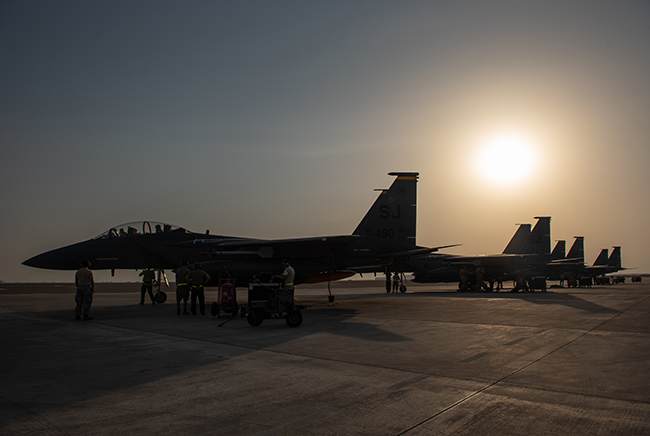
Four F-15E Strike Eagles from the 4th Fighter Wing, Seymour Johnson AFB, N.C., park at Al Dhafra AB, United Arab Emirates, on June 13, 2019. The F-15Es joined ADAB's inventory of other fighters to include F-15C Eagles and F-35A Lightning IIs. Air Force photo by SSgt. Chris Thornbury.
F-15Es from Seymour Johnson AFB, N.C., touched down at Al Dhafra AB, United Arab Emirates, on June 13 as part of a further buildup of US forces in the Middle East.
The Strike Eagles join F-15Cs and F-35s at Al Dhafra, along with a bomber task force of B-52s recently deployed to Al Udeid AB, Qatar. Additionally, the Pentagon announced unnamed intelligence, surveillance, and reconnaissance aircraft would deploy to the region.
The deployments are part of a response to threats the White House and the Pentagon have said are emanating from Iran. In an announcement about the fighter squadron, Acting Defense Secretary Patrick Shanahan said the aircraft would help “improve our force protection and safeguard US forces.”
On June 16, the Pentagon announced it is sending 1,000 more troops to the region for defensive purposes “to address air, naval, and ground-based threats in the Middle East.” Shanahan said last week’s attacks on two tanker ships in the Persian Gulf “validate the reliable, credible intelligence” on Iranian behavior.
The US points to mines that attach to ships using magnets as the source of the destruction.
As the department tries to make its case that Iran was behind the alleged attacks, the Pentagon on June 17 published a fresh batch of images purportedly showing the Iranian Revolutionary Guard Corps engaging the tankers. A Task and Purpose report that day cited unnamed Navy officials who “acknowledged that nothing in imagery released by the Pentagon shows Iranian Revolutionary Guards planting limpet mines on ships in the Gulf of Oman.”
Retiring Vice Chairman of the Joint Chiefs of Staff USAF Gen. Paul Selva told reporters on June 18 the defense and intelligence communities are doing everything they can to declassify the information for the public.
Selva echoed the assertion that Iran was behind the oil tanker attacks and said it’s very likely they knew where the Japanese and Norwegian ships targeted were from.
“It was, by all accounts as you look at the tactics, techniques, and procedures that were used, a relatively sophisticated attack,” he said. “They’re doing all the preparatory work that’s necessary.”
Admitting he lacks the information to back up the argument, Selva suggested the ships were targeted either because their attackers knew their nationality or because they were approaching an area where the Iranians were sailing.
“I don’t know which one it was, and I’m not sure the intelligence community will ever be able to tell us which one it was,’ Selva noted.
In an interview with the BBC, retired Lt. Gen. Dave Deptula, dean of AFA’s Mitchell Institute, said the attack on the tankers should be an international concern. Deptula suggested “a coalition of nations seeking peace and freedom of navigation in international waters, should really assemble an alliance to denounce Iranian hostile actions, and then form a group to defend against any Iranian attacks in the future.”
BBC News video via AFA
President Donald Trump told Time that Iran’s recent activity has been “very minor.” Selva wouldn’t comment on the President’s remarks but argued the attacks caused only a small disruption to the movement of resources in the region. He indicated military action could still be on the table if disruptions continue or if US-Iran tensions escalate into a conflict.
“I think there is a military role in defending freedom of navigation,” he said. “The question will be to what extent the international community will get behind that role. … It will require an international consensus before force is used, with one specific caveat: If the Iranians come after US citizens, US assets, or the US military, we reserve the right to respond with military action.”
